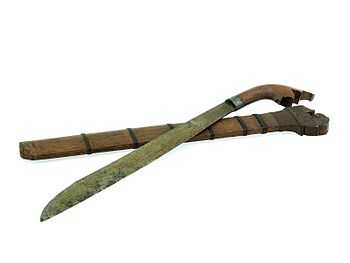Kabeala
| Kabeala | |
|---|---|
|
A Kabeala, pre-1876. | |
| Type | Chopper, Machete |
| Place of origin | East Sumba, Indonesia |
| Service history | |
| Used by | Sumba people |
| Specifications | |
| Length | approximately 50 - 60 cm |
|
| |
| Blade type | Drop point blade with convex edge |
| Hilt type | Water buffalo horn, wood |
| Scabbard/sheath | Wood |
Kabeala (sometimes Kabela, Kabeàla or Kabiala; which means "Parang" or "Golok" in East Sumba language) is a traditional weapon[1] originating from East Sumba, Indonesia.
Description
The Kabeala has a straight-backed blade with a somewhat convex edge. The blade broadens slightly towards the tip. Its back curves towards the edge at the tip. The hilt is solid, curving halfway at an angle of 45 degrees. The scabbard is straight and has a large number of woven strips to keep both parts together. Its mouth has a slanting protrusion towards the blade's sharp side.[2]
Culture
During funerals, a person is chosen to assume the role of a Papanggang (slave) whereby a man would carry a Kabeala while the woman would carry a Kahidi Yutu or Leiding knife.[3][4] The traditional attire of a male Papanggang includes a black Kabeala, a symbol of prince.[5]
References
- ↑ Rodney Needham (1987). Mamboru: History And Structure In A Domain In Northwestern Sumba. Clarendon Press. ISBN 0-1982-3400-7.
- ↑ Albert G Van Zonneveld (2002). Traditional Weapons of the Indonesian Archipelago. Koninklyk Instituut Voor Taal Land. ISBN 9-0545-0004-2.
- ↑ Gregory L. Forth (1981). Rindi: An Ethnographic Study Of A Traditional Domain In Eastern Sumba. Martinus Nijhoff. ISBN 9-0247-6169-7.
- ↑ Somogy (2007). Arts & Culture 2006. Somogy. ISBN 2-8505-6957-7.
- ↑ "The Life And Death Of Tamu Rambu Yuliana, Princess Of Sumba And Custodian Of The Arts And Treasures Of Rindi" (PDF). Arts & Cultures, Barbier-Mueller Museum. Retrieved 3 June 2014.
| Wikimedia Commons has media related to Kabeala. |
| ||||||||||||||||||||||||||||||||||
